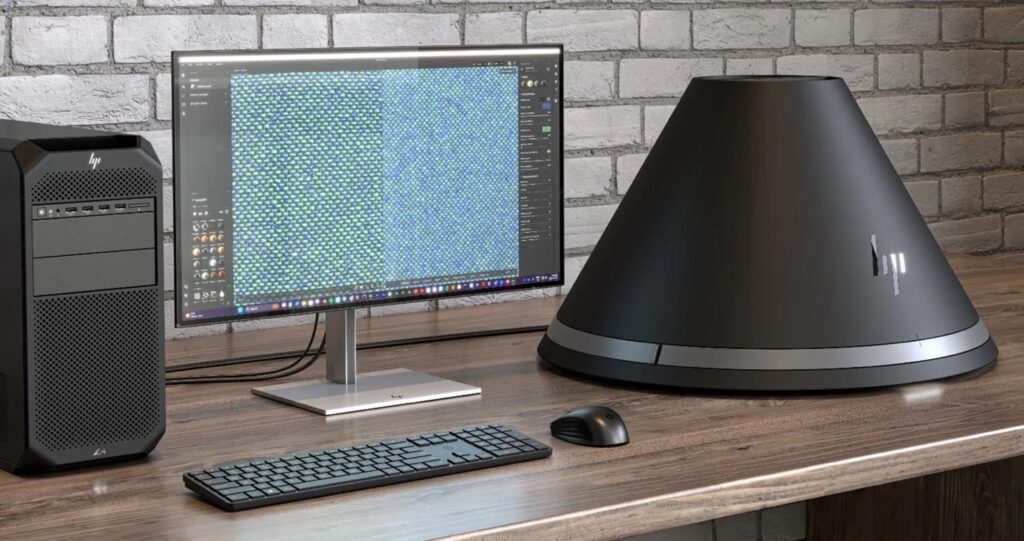HP extends its product line with the HP Z Captis digital material capture system. The system uses a unique array of lights and a camera to snap pictures of the material sample. Adobe Substance 3D Sampler communicates with the Captis unit through HP’s Capture Management SDK. The data from Captis is exported to Substance Sampler, whose tools are used to clean and process the texture data. The physically-based material then can be applied to a 3D model.

At conferences and trade shows like Siggraph, we are used to seeing HP displaying an array of mobile workstations and desktops, often along with visually-stunning monitors. And indeed, the company did show off its latest advancements in AI workstations at this year’s event. Eye-catching, sure. As were the live demos of Z by HP AI Studio. But, there was also something else, something unusual perched atop a counter at company’s exhibition space: the HP Z Captis.
HP used the backdrop of Siggraph 2024 to formally introduce the Captis, with the cone-shaped device (similar to a lampshade) piquing the curiosity of passersby. So, what is Captis? It is a digital material capture system, built in collaboration with Adobe, that enables 3D creators to sample and remix reality through direct integration with Adobe Substance 3D Sampler (sold separately), Adobe’s product for creating physically-based materials.
The Captis system is powered by an embedded Nvidia Jetson AGX Xavier system-on-module at the top of the cone, for efficient image processing. Also included is HP’s Capture Management SDK, which provides users with APIs for developing computer vision, AI, and local inference applications on the Captis.
The scanning process starts with the user placing the material to be scanned inside the unit, atop the bottom base, which pivots outward from the top part of the cone.
Within the Captis device itself is a polarizer and a 108MP smartphone camera connected via MIPI (Mobile Industry Processor Interface) to the embedded Jetson AGX Xavier module, streaming 12,000×9,000 RAW images directly into the GPU’s memory and capturing up to 1.2TB for each capture sequence, says HP. An array of tiny lights within the cone illuminates in various combinations while a multitude of photos are taken. Meanwhile, HP’s Capture Management SDK is integrated into Substance Sampler, enabling it to communicate with the Captis unit. The data from Captis is exported to Substance Sampler, whose tools are used to clean and process the texture data, producing four different maps—normal, height, opacity, and color—to illustrate features like roughness, shininess, and so forth. The physically-based material then can be applied to a 3D model incorporated into 3D workflows through the Substance Sampler integration. The model can be used in everything from digital product creation to manufacturing and marketing.
With the new Substance Connector tool, the material can be exported with a single click to Autodesk’s Maya, Epic’s Unreal Engine, or Blender, with support for other offerings coming in the future, according to Adobe.
Using Substance Sampler’s tools, users can change filters, for instance, to make all types of adjustments to the scanned material. They can even expose a parameter, such as color value, and after exporting the material to their 3D software program, like Unreal Engine, using the Substance plug-in, they can then change the material color in that 3D program. As a result, users can create a collection of images with a wide array of colors.
As HP notes, the concept of photometric stereo capture has been around for some time, but it has been a fragmented landscape of expensive specialized or DIY solutions. Joshua St. John, product director at HP, in collaboration with Jerome Derel, a researcher from Adobe, began Project Captis in 2019 to develop a push-button solution to make this technology more accessible.
Built for accuracy, the Captis digitizes swatches or surfaces in minutes. Materials can be captured in up to 8K resolution using the polarized, photometric computer vision system, powered by the AGX Xavier module, with up to 32 TOPS of AI performance, says HP.
The device is modular and has two usage modes. Studio mode is for samples up to 30cm×30cm (approximately 11.8×11.8 inches) on a backlight base; Explorer mode has a battery to enable portability and uses an open bottom to capture surfaces up to 60cm×60cm (roughly 23.6×23.6 inches).
For more information on Captis, go here.
As Madonna’s popular song “Material Girl” goes, “’Cause we are living in a material world, and I am a material girl.”